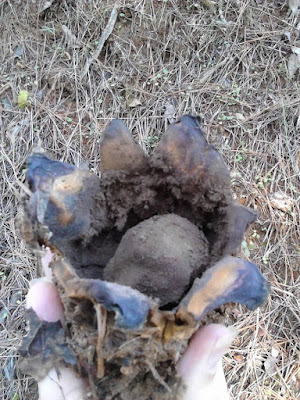First and foremost, what is "war water" exactly? Well, you first have to understand the term "water" in traditional rootwork and conjure does not necessarily mean dihydrogen monoxide like what comes from taps. When we talk about "waters" what we actually mean is a liquid agent or solution which mat be based in any number of fluid media. "Four thieves vinegar" and "carmelite water" are both "waters" but one is based in vinegar and the other in ethyl alcohol. The war water we are making today is two-part and the final product actually has a third, but we will get to that in time.
War water is often avoided by new-agers because it sounds scary and is commonly associated with "dark magic" or "evil intent" which is not really the case. It has a variety of applications, mostly protective, but it can be used aggressively too. In either case, it is something every serious practitioner should have on hand at all times because it takes a long time to get a good "starter" going, and it is the kind of thing it is better to have and not need, than to need and not have. The beauty part is you can always order some from me and use that to "jump start" your own.
So how do you use it? Well, it can be sprinkled around your property to erect a powerful barrier against both free-range spirits and harmful work and energies sent by other people. You can put the names of troublesome people into it to turn their evil back on them or render them powerless against you. You can splash a little over any tricks you find laid in your path to nullify them, or you can put it in an enemy's foot track so that they are dogged down by their own wickedness. It is good in "witch bottles" or other protective talismans of the sort and some will use it in the popular "freezer spell" to stop troublesome influences.
To make war water the way I do, you will need the following materials
- 2 large glass jars, preferably with glass lids and rubber gaskets.
- Distilled white vinegar
- Salt
- A railroad spike
- A carbon steel hunting knife, stripped of it's furniture (handles etc)
- Ordinary water
For the second part, we are going to first heat the vinegar to just about boiling. You can use a microwave for this, it is just to help jump-start the oxidation process. To the hot vinegar, add salt. Again, any kind will do, no need to get fancy here. You want a good amount, maybe a half a cup to a quart. Mix it in good then drop your knife in. I used to use this method to form a patina on my handmade knives to make them look interesting. For this, we are actually taking the knife itself and infusing the vinegar with it. If you do this and keep it going for a long time, eventually the knife will disintegrate entirely. Mine did, but it took about 3 years. You want to make sure to have a glass lid on this one, or to change lids often, because this stuff WILL eat through a regular Mason jar lid in no time.
It helps to let these breath for at least the first 24-48 hours, and then to give them a day or two of air every now and then after. When rust starts to form and tinge the water, give the jars a careful shake... more of a "swirl" really, just to keep the rust suspended int he water and new oxide layers forming constantly. Once it gets going, you can ignore them for longer and longer periods. I check mine about once a month. Eventually your railroad spike water will turn muddy looking and the knife-vinegar solution will turn almost black and you will see little flakes of metal swimming around in there if you look closely. After a year or so you will have some pretty good product and then you can combine the two liquids, refill the jars, and start another batch. Be sure and leave some of the sediment in the bottom so you get it going even faster this time. For storage, I recommend the heavy plastic jugs they sell vinegar in at the supermarket.
 |
| "Devil's snuffbox" is a puffball mushroom after it has matured and "puffed" it looks gnarled and burnt on the outsides, and contains spore powder, which we call "Devl's snuff" |

i can recommend love-spell-reviews.com
ReplyDelete